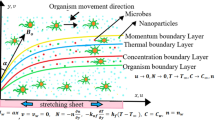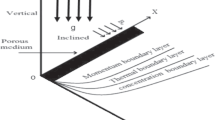Abstract
The nanofluids under magnetic fields show great potential in microchannel cooling and thermal absorption of the miniaturized devices. Studies about the lattice Boltzmann method (LBM) have been focusing on the effects of nanoparticle types, volume fractions, and magnetic field intensity at low Reynolds numbers. However, less effort has been made to elucidate the interactions between external forces at large Reynolds numbers. In this work, we firstly developed a preconditioned LBM (PLBM) to overcome the divergence problem of the original LBM caused by variable physical properties and Reynolds numbers, followed by investigating the thermo-hydraulic characteristics of Al2O3-water nanofluid in a microchannel with temperature-dependent physical properties and slip boundary conditions. The effects of the external magnetic field, buoyancy force, and volume fraction of nanoparticles are discussed, and the entropy generation is analyzed. When the magnetic field is applied, the average shear stress is twice that without a magnetic field and the average Nusselt number increases by about 10% and further by about 20% at higher buoyancy forces. Besides, the magnitudes of the entropy generation caused by magnetic field irreversibility are higher than that caused by the heat transfer irreversibility. The numerical study developed in this work elucidates the effects of external force and extends the simulation performance of the existing LB models.













Similar content being viewed by others
Abbreviations
- B :
-
Dimensionless slip factor
- B 0 :
-
Magnetic field intensity
- B e :
-
Bejan number
- c :
-
Absolute molecular velocity
- c i :
-
Lattice discrete velocity
- C f :
-
Friction coefficient
- c s :
-
Lattice speed of sound
- c p :
-
Specific heat
- d s :
-
Nanoparticle diameter
- D H = 2H :
-
Characteristic length
- f g :
-
Density and energy distribution functions
- F i :
-
Force term
- \(\tilde{f}_{\text i}\), \(\tilde{g}_{\text i}\) :
-
Modified discrete density and energy distribution functions
- G 1 :
-
Magnetic force
- G 2 :
-
Buoyancy force
- H a :
-
Hartmann number
- H, L :
-
Height and length
- k :
-
Fluid thermal conductivity
- N u :
-
Nusselt number
- Pr :
-
Prandtl number
- q :
-
Heat flux
- r :
-
Momentum accommodation coefficient
- R :
-
Gas constant
- R i :
-
Richardson number
- Re :
-
Reynolds number
- T :
-
Temperature, K
- u :
-
Velocity vector
- U,V :
-
Dimensionless velocity components
- u,v :
-
Velocity components, m s−1
- Z :
-
Heat dissipation term
- α :
-
Thermal diffusivity coefficient
- β :
-
Thermal expansion coefficient
- γ :
-
Gas-specific heat ratio
- ξ :
-
Preconditioned parameter
- θ :
-
Dimensionless temperature
- μ :
-
Dynamic viscosity, Pa S
- ν :
-
Kinematic viscosity, m2 s−1
- ρ :
-
Fluid density, kg m−3
- σ :
-
Electrical conductivity, (Ω m)−1
- τ f , τ g :
-
Dimensionless relaxation times for momentum and internal energy
- φ :
-
Nanoparticles volume fraction
- eq:
-
Equilibrium
- eff:
-
Effective
- f :
-
Fluid
- i :
-
Lattice coordinate direction
- in: :
-
Inlet value of the microchannel
- n f :
-
Nanofluid
- s :
-
Solid
- w :
-
Wall
References
Mohammadpour J, Lee A, Mozafari M, Zargarabadi MR, Mujumdar AS. Evaluation of Al2O3-Water nanofluid in a microchannel equipped with a synthetic jet using single-phase and Eulerian-Lagrangian models. Int J Therm Sci. 2021;161:106705.
Monavari A, Jamaati J, Bahiraei M. Thermohydraulic performance of a nanofluid in a microchannel heat sink: use of different microchannels for change in process intensity. J Taiwan Inst Chem Eng. 2021;125:1–14.
Heidarshenas A, Azizi Z, Peyghambarzadeh SM, Sayyahi S. Experimental investigation of heat transfer enhancement using ionic liquid-Al2O3 hybrid nanofluid in a cylindrical microchannel heat sink. Appl Therm Eng. 2021;191:116879.
Mirzaei M, Dehghan M. Investigation of flow and heat transfer of nanofluid in microchannel with variable property approach. Heat Mass Transfer. 2013;49:1803–11.
Salman BH, Mohammed HA, Kherbeet AS. Numerical and experimental investigation of heat transfer enhancement in a microtube using nanofluids. Int Commun Heat Mass Transfer. 2014;59:88–100.
M’hamed B, Sidik NAC, Yazid MNAWM, Mamat R, Najafi G, Kefayati GHR. A review on why researchers apply external magnetic field on nanofluids. Int Commun Heat Mass Transf. 2016;78:60–7.
Sheikholeslami M, Rokni HB. Simulation of nanofluid heat transfer in presence of magnetic field: a review. Int J Heat Mass Transf. 2017;115:1203–33.
Moshfefgh A, Mehrizi AA, Javadzadegan A, Joshaghani M, Ghasemi-Fare O. Numerical investigation of various nanofluid heat transfer in microchannel under the effect of partial magnetic field: lattice Boltzmann approach. J Therm Anal Calorim. 2020;140:773–87.
Mehrizi AA, Besharati F, Jahanian O, Afrouzi HH. Numerical investigation of conjugate heat transfer in a microchannel with a hydrophobic surface utilizing nanofluids under a magnetic field. Phys Fluids. 2021;33:052002-1-052002–13.
Jurčevič M, Nižetič S, Arıcı M, Ocłoń P. Comprehensive analysis of preparation strategies for phase change nanocomposites and nanofluids with brief overview of safety equipment. J Clean Prod. 2020;274:122963.
Nižetić S, Jurčevič M, Arıcı M, Arasu AV, Xie GN. Nano-enhanced phase change materials and fluids in energy applications: a review. Renew Sustain Energy Rev. 2020;129:109931.
Alagumalai A, Qin CY, Vimal KEK, Solomin E, Yang L, Zhang P, Otanicar T, Kasaeian A, Chamkha AJ, Rashidi MM, Wongwises S, Ahn HS, Lei Z, Saboori T, Mahian O. Conceptual analysis framework development to understand barriers of nanofluid commercialization. Nano Energy. 2022;92:106736.
Moshizi SA, Malvandi A. Magnetic field effects on nanoparticle migration at mixed convection of MHD nanofluids flow in microchannels with temperature-dependent thermophysical properties. J Taiwan Inst Chem Eng. 2016;66:269–82.
Malvandi A, Moshizi SA, Ganji DD. Effects of temperature-dependent thermophysical properities on nanoparticle migration at mixed convection of nanofluids in vertical microchannels. Powder Technol. 2016;303:7–19.
Arefmanesh A, Aghaei A, Ehteram H. Mixed convection heat transfer in a CuO-water filled trapezoidal enclosure, effects of various constant and variable properties of the nanofluid. Appl Math Model. 2016;40:815–31.
Sheikhzadeh GA, Qomi ME, Hajialigol N, Fattahi A. Numerical study of mixed convection flow in a lid-driven enclosure filled with nanofluid using variable properties. Results Phys. 2012;2:5–13.
J. Li, Computational analysis of nanofluid flow in microchannels with applications to micro-heat sinks and bio-MEMS, PhD Thesis, Raleigh, North Carolina, the United States: North Carolina State University, 2008.
Karimipour A, D’Orazio A, Shadloo MS. The effects of different nanoparticles of Al2O3 and Ag on the MHD nanofluid flow and heat transfer in a microchannel including slip velocity and temperature jump. Physica E. 2017;86:146–53.
Lalami AA, Afrouzi HH, Moshfegh A, Omidi M, Javadzadegan A. Investigation of nanofluid heat transfer in a microchannel under magnetic field via lattice Boltzmann method: effects of surface hydrophobicity, viscous dissipation, and Joule heating. J Heat Transfer-Trans ASME. 2019;141:062403-1-062403–10.
Sheikholeslami M, Gorgi-Bandpy M, Ganji DD. Numerical investigation of MHD effects on Al2O3-water nanofluid flow and heat transfer in a semi-annulus enclosure using LBM. Energy. 2013;60:501–10.
Fattahi A. LBM simulation of thermo-hydrodynamic and irreversibility characteristics of a nanofluid in microchannel heat sink under affecting a magnetic field. Energy Sour, Part A: Recovery, Util Environ Effects. 2020. https://doi.org/10.1080/155670362020.
Kalteh M, Abedinzadeh SS. Numerical investigation of MHD nanofluid forced convection in a microchannel using lattice Boltzmann method. Iran J Sci Technol Trans Mech Eng. 2018;42:23–4.
Ghadirzadeh S, Kalteh M. Lattice Boltzmann simulation of temperature jump effect on the nanofluid heat transfer in an annulus microchannel. Int J Mech Sci. 2017;133:524–34.
Afrouzi HH, Hosseini M, Toghraie D, Mehryaar E, Afrand M. Thermo-hydraulic characteristics investigation of nanofluid heat transfer in a microchannel with super hydrophobic surfaces under non-uniform magnetic field using incompressible preconditioned lattice Boltzmann method (IPLBM). Physica A-Stat Mech Appl. 2020;553:124669-1-124669–21.
Zhou JF, Gu G, Meng XN, Shao CL. Effect of alternating gradient magnetic field on heat transfer enhancement of magnetoreological fluid flowing through microchannel. Appl Therm Eng. 2019;150:1116–25.
Ltaifa KB, D’Orazio A, Dhahri H. Numerical analysis of mixed convection heat transfer and laminar flow in a rectangular inclined micro-channel totally filled with water/Al2O3 nano fluid. J Therm Anal Calorim. 2021;144:2465–82.
Servati AA, Javaherdeh VK, Ashorynejad HR. Magnetic field effects on force convection flow of a nanofluid in a channel partially filled with porous media using lattice Boltzmann method. Adv Powder Technol. 2014;25:666–75.
Ma Y, Mohebbi R, Rashidi MM, Yang ZG. MHD forced convection of MWCNT-Fe3O4/water hybrid nanofluid in a partially heated s-shaped channel using LBM. J Therm Anal Calorim. 2019;136:1723–35.
Lalami AA, Afrouzi HH, Moshfegh A. Investigation of MHD effect on nanofluid heat transfer in microchannels: an incompressible lattice Boltzmann approach. J Therm Anal Calorim. 2019;136:1959–75.
He XY, Chen SY, Doolen GD. A novel thermal model for the lattice Boltzmann method in incompressible limit. J Comput Phys. 1998;146:282–300.
Zhang YC, Xie GN, Karimipour A, Sunden B. LBM modeling and analysis on microchannel slip flow and heat transfer under different heating conditions. Numer Heat Transf Part A-Appl. 2020;78:159–79.
Li J, Kleinstreuer C. Thermal performance of nanofluid flow in microchannels. Int J Heat Fluid Flow. 2008;29:1221–32.
Maxwell JC. A treatise on electricity and magnetism, vol. II. Cambridge, UK: Oxford University Press; 1873.
Brinkman HC. The viscosity of concentrated suspensions and solutions. J Chem Phys. 1952;20:571–81.
Shu C, Niu XD, Chew YT. A lattice Boltzmann kinetic model for microflow and heat transfer. J Stat Phys. 2005;121:239–55.
Jery AE, Hidouri N, Magherbi M, Brahim AB. Effect of an external oriented magnetic field on entropy generation in natural convection. Entropy. 2010;12:1391–417.
Srinivasacharya D, Bindu KH. Entropy generation in a porous annulus due to micropolar fluid flow with slip and convective boundary conditions. Energy. 2016;111:165–77.
Acknowledgements
This research was supported by Shenzhen Science and Technology Program (JCYJ20210324142812032), the Major Program of the Natural Science Foundation of Shandong Province (ZR2019ZD11), and the National 111 Project (B18041).
Author information
Authors and Affiliations
Corresponding authors
Additional information
Publisher's Note
Springer Nature remains neutral with regard to jurisdictional claims in published maps and institutional affiliations.
Rights and permissions
About this article
Cite this article
Zhang, Y., Li, W., Li, Y. et al. Thermo-hydraulic characteristics of Al2O3-water nanofluid by preconditioned LBM. J Therm Anal Calorim 147, 9811–9827 (2022). https://doi.org/10.1007/s10973-022-11197-8
Received:
Accepted:
Published:
Issue Date:
DOI: https://doi.org/10.1007/s10973-022-11197-8




